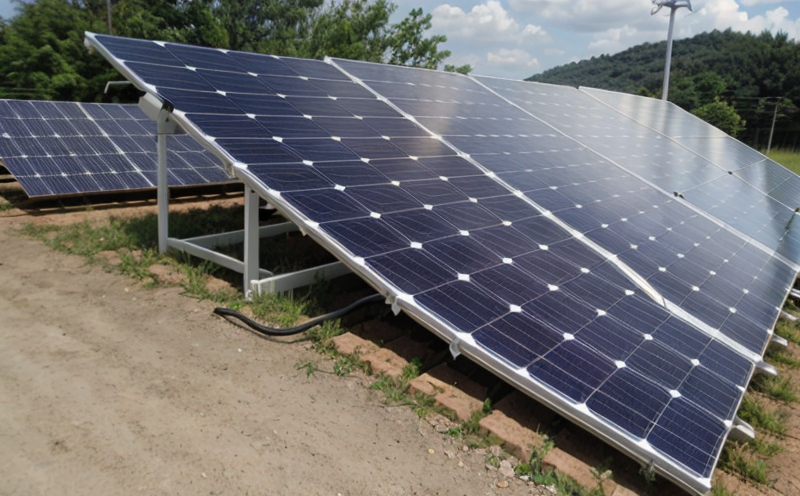IEC 61215-2 Insulation Resistance Testing
The IEC 61215 series of standards is a comprehensive set designed to ensure the quality, safety, and reliability of photovoltaic (PV) modules. IEC 61215 specifically addresses the performance requirements for solar photovoltaic cells, submodules, and modules. Among its various parts, IEC 61215-2 focuses on insulation resistance testing.
The primary purpose of this test is to evaluate the electrical isolation between different conductors within a PV module or submodule. Insulation resistance plays a crucial role in ensuring that components are properly isolated from each other and from ground, preventing short circuits and enhancing overall safety. This type of testing ensures compliance with IEC 61215-2 standards, which require modules to have sufficient insulation resistance to withstand specified voltages without failure.
The test involves applying a high voltage across the conductors being tested while measuring the resulting current flow through the insulation material. Based on the measured resistance value and applied voltage, an acceptable range is determined for each conductor within the module. Non-conformity with these requirements can indicate potential issues such as poor manufacturing processes or inadequate materials.
When preparing specimens for IEC 61215-2 testing, it's essential to follow precise procedures outlined in the standard. Properly cleaning and conditioning samples helps ensure accurate test results by eliminating any external factors that could interfere with measurements. Specimens must be conditioned at specified environmental conditions before being placed into the test fixture.
The equipment required for this type of testing includes a high-voltage source capable of delivering the necessary voltage levels, an ohmmeter or similar device to measure resistance values during and after application of the test voltage, and appropriate fixtures designed specifically for holding individual components within the module while performing tests. Compliance with IEC 61215-2 requires that all critical parameters be meticulously recorded and documented throughout the entire testing process.
Results from this test are essential in determining whether a particular PV module meets international safety regulations like those set forth by IEC (International Electrotechnical Commission). By ensuring proper insulation resistance between various parts of the solar panel, manufacturers can guarantee safer operation under real-world conditions while also protecting consumers against potential hazards associated with improper electrical connections.
Compliance with IEC 61215-2 ensures that the product meets stringent quality and safety standards established by recognized international bodies. This not only enhances consumer confidence but also promotes fair competition among manufacturers worldwide who adhere to these globally accepted guidelines.
Industry Applications
IEC 61215-2 Insulation Resistance Testing finds application across multiple sectors, particularly in the renewable energy sector where PV modules play a significant role. This testing is vital for quality assurance and ensuring that solar panels meet safety requirements before being deployed into service.
- Solar Energy Production: Ensures safe operation of photovoltaic systems by verifying proper insulation between conductors, reducing the risk of electrical hazards.
- Renewable Energy Projects: Supports large-scale installations by validating that each component complies with international safety standards.
- Solar Module Manufacturing: Provides quality control during production processes to maintain consistent product performance and reliability.
| Industry Sector | Application |
|---|---|
| Renewable Energy Production | Ensures safe operation of photovoltaic systems by verifying proper insulation between conductors, reducing the risk of electrical hazards. |
| Solar Module Manufacturing | Provides quality control during production processes to maintain consistent product performance and reliability. |
The data provided in this table highlights how IEC 61215-2 testing contributes to various aspects of the solar energy industry, emphasizing its importance for both manufacturing processes and operational safety. By adhering to these rigorous standards, manufacturers can ensure their products meet international quality benchmarks, thereby fostering trust among consumers and stakeholders.
International Acceptance and Recognition
The IEC 61215-2 Insulation Resistance Testing is widely recognized across the globe as a critical aspect of photovoltaic module design and manufacturing. Many countries have incorporated its requirements into their national standards, ensuring consistency in safety regulations worldwide.
For instance, China's GB/T 24397 standard mandates compliance with IEC 61215-2 for all PV modules intended for commercial use within the country. Similarly, India follows similar guidelines under its Bureau of Indian Standards (BIS) norms. These national standards align closely with international practices set forth by organizations like the International Electrotechnical Commission (IEC), which oversees IEC 61215-2.
In addition to national regulations, many global certification bodies such as TÜV, UL, and Intertek also require proof of compliance with IEC 61215-2 when issuing certifications for PV products. Such certifications indicate that the manufacturer has met stringent quality assurance criteria established by recognized international authorities.
The widespread acceptance of IEC 61215-2 underscores its significance in promoting safety and reliability within the photovoltaic industry. By adhering to these standards, manufacturers can ensure their products meet global expectations for performance and safety, opening up opportunities for export into markets that enforce similar requirements.
Use Cases and Application Examples
IEC 61215-2 Insulation Resistance Testing is applicable in diverse scenarios within the photovoltaic industry. One common use case involves quality assurance during manufacturing processes, where each batch of solar panels undergoes rigorous testing to ensure consistent performance across all units produced.
- New Product Development: During R&D phases, companies may conduct extensive tests on prototypes to identify any potential issues early in the design lifecycle.
- Production Line Quality Control: Continuous monitoring ensures that every manufactured unit adheres strictly to specified specifications throughout large-scale production runs.
- Field Installation Verification: After installation at remote locations, modules may undergo periodic inspections to check for any signs of degradation or damage over time.
In each case, compliance with IEC 61215-2 provides assurance that the product meets strict safety and performance criteria set forth by international bodies. This not only protects end-users but also helps maintain a high level of trust among consumers who rely on reliable solar energy solutions.





